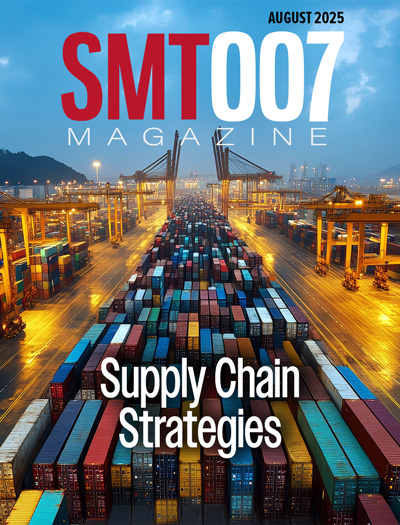-

- News
- Books
Featured Books
- smt007 Magazine
Latest Issues
Current Issue
Spotlight on India
We invite you on a virtual tour of India’s thriving ecosystem, guided by the Global Electronics Association’s India office staff, who share their insights into the region’s growth and opportunities.

Supply Chain Strategies
A successful brand is built on strong customer relationships—anchored by a well-orchestrated supply chain at its core. This month, we look at how managing your supply chain directly influences customer perception.

What's Your Sweet Spot?
Are you in a niche that’s growing or shrinking? Is it time to reassess and refocus? We spotlight companies thriving by redefining or reinforcing their niche. What are their insights?
- Articles
- Columns
- Links
- Media kit
||| MENU - smt007 Magazine
IPC APEX EXPO Takeaways
April 2, 2018 | Stephen Las Marias, I-Connect007Estimated reading time: 4 minutes
I am always impressed with the amount of new equipment, solutions, and technologies being showcased at IPC APEX EXPO. It is just my third year of attending the show, but it has grown year after year since I attended it for the first time in Las Vegas. That was in 2016—the same year my colleague Patty Goldman was honored with the IPC Raymond E. Pritchard Hall of Fame Award.
In that year’s show, one of my takeaways was the increasing automation on the factory floor. I remember interviewing Rethink Robotics’ Carl Palme about their collaborative robot, Sawyer, and why it can be a flexible solution for high-mix, low-volume operations.
Last year, my takeaway was the trend towards smarter manufacturing or Industry 4.0, and how the Internet of Things (IoT) and data/analytics was enabling these trends. In fact, I interviewed Cogiscan’s Francois Monette, and we talked about how the industry can meet the challenge of connecting different machines, software, and enterprise systems to enable Industry 4.0 for the electronics assembly industry.
This year, my takeaway is the fruition of all these efforts toward the goal of a connected factory. In particular, the IPC Connected Factory Exchange (CFX) live demo highlighted how the CFX standard will enable manufacturers to track their efficiencies better, prevent issues even before they happen, and make adjustments wherever needed, to name a few.
Although there are still many issues to iron out with the CFX standard, its implementation is quick and easy—once an equipment manufacturer really commits to it. In fact, according to David Fenton of Europlacer Americas, one of the participating companies at the demo, they were not aware of CFX until about four weeks before the show. Once the company committed to it, it only took them 48 hours to implement the standard in their systems and connect through the cloud to start providing real-time machine data, which—in the demo—may be accessed through a mobile phone.
What’s really interesting here is that machine vendors from across the whole industry that normally compete against one another have joined together to demonstrate support for the CFX standard.
At this year’s IPC APEX EXPO, I was also able to attend the EMS Management Council Meeting where key executives in the EMS industry met to talk about the state of the industry and key issues that are greatly impacting their business. Here are my 2018 takeaways.
The industry as a whole is expected to continue its strong growth achieved last year. In his presentation, Walt Custer of Custer Consulting said most sectors have expanded in 2017, driven by the automotive and IoT trends. He expects “tremendous growth” this year, but a possible dip next year. He sees 5G as the next “boom” for the industry.
IPC’s Sharon Starr’s presentation, focused on the EMS sector, projected sustained growth in the electronics assembly industry from 2016 to 2022, but at a slowing rate, and ODM growth outpacing EMS growth.
Presenting on counterfeit devices, Tom Sharpe of SMT Corporation notes that “clones” are now becoming more sophisticated. Counterfeiters’ reverse engineering of logic devices and functional die emulation of analog-to-digital converters, despite noticeable differences, are becoming near accurate, with some designs showing improvements in semiconductor real estate. Clones now have electrical data almost similar to the specs of authentic devices, and even come with counterfeit OCM (original component manufacturer) documents. According to Sharpe, while good exterior visual inspection performed by a well-trained inspector will catch a very high percentage of refurbished/ reworked or physically altered counterfeit components, this is not the case with the better clone devices that they are now analyzing.
Aegis Software’s Michael Ford talked about transforming the electronics manufacturing industry from Industry 3.0—processes that include manual CAD and BOM, manual splitting of data, visual process control, ERP driven material kits, and ad-hoc data recording—to Industry 4.0, which is based on digitalization and IoT. According to Ford, Industry 4.0 will feature digitalized processes: from product model to process engineering and control, to supply chain and build record—enabling decision making in seconds, NPI in minutes, automated active quality, and continuous optimization.
Finally, whether we like it or not, the smart manufacturing revolution is happening. Jay Gorajia of Mentor, a Siemens Business, presented on data analytics and the connected supply chain, and how a common digital thread applied across the entire value chain will help manufacturers compress the innovation lifecycle and enable continuous business transformation.
Overall, it is such an interesting time to be in this industry. Industry 4.0 is all about accurate data and how this can help improve and optimize the electronics manufacturing process. This year’s IPC APEX EXPO highlighted that. With the successful conclusion of the CFX demo, I am sure equipment manufacturers will now rethink their strategies and consider how they can be a part of this digital transformation happening in the supply chain.
This article was initially published from I-Connect007’s inaugural Show & Tell Magazine.
Testimonial
"In a year when every marketing dollar mattered, I chose to keep I-Connect007 in our 2025 plan. Their commitment to high-quality, insightful content aligns with Koh Young’s values and helps readers navigate a changing industry. "
Brent Fischthal - Koh YoungSuggested Items
Building Electronics Excellence in India
09/08/2025 | Nolan Johnson, SMT007 MagazineFor over two decades, Dave Bergman has helped steer the Global Electronics Association’s work in India, from a single training course to a thriving regional operation with deep government and industry ties. In this interview, Dave explains how the group went from partnering with IPCA to opening its own office in 2010, creating India’s first domestic electronics manufacturing standard, and securing funding for dozens of Indian companies to attend U.S. trade shows.
New Podcast Episode Drop: MKS’ Atotech’s Role in Optimize the Interconnect
09/08/2025 | I-Connect007In this episode of On the Line With…, host Nolan Johnson sits down with Patrick Brooks, MKS' Atotech's Global Product Director, EL Systems, to discuss the critical role that wet processes play alongside laser systems in advancing the Optimize the InterconnectSM initiative. Brooks points to Bondfilm as a key example—a specialized coating that enables CO₂ lasers to ablate more effectively than ever before.
The Global Electronics Association Hosts Successful WorksAsia-AI and Factory of the Future Technical Seminar
09/03/2025 | Global Electronics AssociationOn August 22, 2025, the Global Electronics Association hosted the successful WorksAsia-AI and Factory of the Future Technical Seminar during the exhibition Automation Taipei 2025. The seminar brought together 81 representatives from 58 companies, focusing on the latest applications of AI in smart factories and unveiling four key directions that will drive the electronics industry’s transition toward intelligence and sustainability.
TRI's AI-Powered Inspection Solutions at SMTAI 2025
09/02/2025 | TRITest Research, Inc. (TRI), the leading provider of test and inspection systems, will be joining the SMTA International Exposition & Conference. The event will be held from October 21 – 23, 2025, at the Donald E. Stephens Convention Center in Rosemont, IL, USA.
More Than a Competition: Instilling a Champion's Skill in IPC Masters China 2025
09/01/2025 | Evelyn Cui, Global Electronics Association—East AsiaNearly 500 elite professionals from the electronics industry, representing 18 provinces and municipalities across China, competed in the 2025 IPC Masters Competition China, March 26–28, in Pudong, Shanghai. A total of 114 contestants advanced to the practical competition after passing the IPC Standards Knowledge Competition. Sixty people competed in the Hand Soldering and Rework Competition (HSRC), 30 in the Cable and Wire Harness Assembly Competition (CWAC), and 24 in the Ball Grid Array/Bottom Termination Components (BGA/BTC) Rework Competition.


